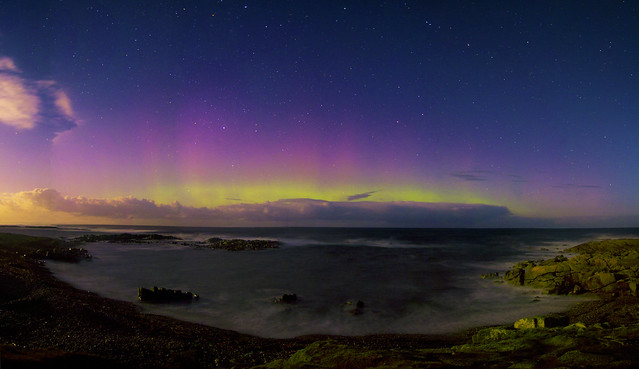[attachment=0]FlamingStar_Boren.jpg[/attachment]
http://ic2.pbase.com/o4/27/876727/1/147 ... pixels.jpg
This image is: 1450x1079 pixels / 4.23"/Pixel
Location RA 05h 15m 52s, Dec +34° 31' 43" / Position Angle +270°43'
The Flaming Star nebula got its name from the appearance of the red ionized hydrogen and blue reflecting dust surrounding AE Aurigae - the brightest star in this image.
Just as As Mu Columbae speeds to the south away from Orion's Trapezium, from where it was hurled (rather from near where, since the Trapezium was not yet born), AE Aurigae zips away to the north - the two separating at some 200 km/sec.
The idea is that around two million years ago two massive binary stars collided close to where the M42 Trapezium now finds itself, in the middle of Orion's Sword. Two stars were exchanged to make the odd eccentric double Iota Orionis, while the other two were ejected to create the classic "runaway stars" mentioned, one of which is AE Aurigae.
AE Aurigae is a 5.96 mag. star, while the two-letter name implies variability (between magnitudes 5.4 and 6.1). The apparent faintness is a product of great distance (near 1450 light years, just a bit farther than Mu Col), and a significant amount of absorption by interstellar dust, which if it were not there would make AE Aur 0.8 magnitudes brighter, boosting it to mid-fifth.
Not surprisingly, Mu Col and AE Aur are similar, both class O (O9.5) hydrogen-fusing dwarfs, AE's temperature measured at 36,500 Kelvin and between 26,000 and 33,000 times the luminosity of the Sun, and at least 17 times solar masses, with a radius about 5 times that of the Sun.
Like the Pleiades in Taurus, AE is now passing through an unrelated interstellar cloud of gas and dust that it is illuminating.
Hot stars, with their simple spectra, make ideal backgrounds for the study of the spectra of intervening interstellar gases (which are superimposed on the stellar spectra), and AE is no exception. Indeed its very high speed across the line of sight of 90 km/s relative to the Sun allows the fine structure of the interstellar medium to be probed as the star passes in back of the wispy gasses, causing the interstellar spectrum to vary. There is really nothing all that unusual in such stars; some 15 % of O and B stars are runaways, some caused by binary interchange, others - like Zeta Ophiuchi - caused by one of the stars of a binary exploding off-center and ejecting the other.
AE's fate is to explode as well, but as a single star which will someday be no more but for a lonely neutron star left behind.
Most of this text is taken from Jim Kaler's
http://stars.astro.illinois.edu/sow/aeaur.html
